The NVIDIA GeForce GTX 1070 Ti Founders Edition Review: GP104 Comes in Threes
by Nate Oh on November 2, 2017 9:00 AM EST- Posted in
- GPUs
- GeForce
- NVIDIA
- Pascal
- GTX 1070 Ti
Overclocking
As NVIDIA is pushing the GTX 1070 Ti for overclocking, it is only fair that we look into it. While NVIDIA does support overclocking, they have limited actual overvolting, and instead providing the ability to unlock 1-2 more boost bins and associated voltages. Using Precision XOC, we adjusted the core and memory clocks, as well as the power/temperature limit and percent 'overvoltage.' For the 180W GTX 1070 Ti, the TDP and TDP limit match the GTX 1080, resulting in a 120% power limit (216W). The 1.093v boost voltage is no surprise, matching the GTX 1080 and 1070 FEs.
| GTX 1070 Ti FE Overclocking | ||||
| Stock | Overclocked | |||
| Core Clock | 1607MHz | 1787MHz | ||
| Boost Clock | 1683MHz | 1863MHz | ||
| Max Boost Clock | 1898MHz | 2078MHz | ||
| Memory Clock | 8Gbps | 8.8Gbps | ||
| Max Voltage | 1.062v | 1.093v | ||
The results, of course, cannot be taken as representative of all GTX 1070 Ti Founders Editions, as this is only a sampled sample size of one. But results here can offer some insight. For one, if there were explicit actual overvolting, it seems very possible to stabilize ~2100+MHz clocks on the GTX 1070 Ti Founders Edition. At any rate, GPU overclocks topped out with observed clocks in the high 2000MHz region, roughly 10% over the previously measured average in-game clockspeeds. Memory overclocks were only able to go up 200MHz from the base 2002MHz, or also about 10%. All-in-all, very similar to the GTX 1070 FE, which also managed 10% overclocks on both GPU and GDDR5 memory. Recalling that the GTX 1070 Ti FE clocked on average just 2% higher than the GTX 1070 FE at stock, there's nothing particularly groundbreaking here, especially considering the 20-25% overclock capability of Maxwell 2 reference cards.
A total of four different overclocks were tested. First was a baseline, consisting of 100% overvoltage and max power/temperature limits. The second was overclocking the GDDR5 memory by 800Mbps. The third was overclocking the GPU with a +180MHz offset; in practice this resulted in observed clocks between 2030 - 2080MHz. Lastly, all previous adjustments were combined for an overall overclock.
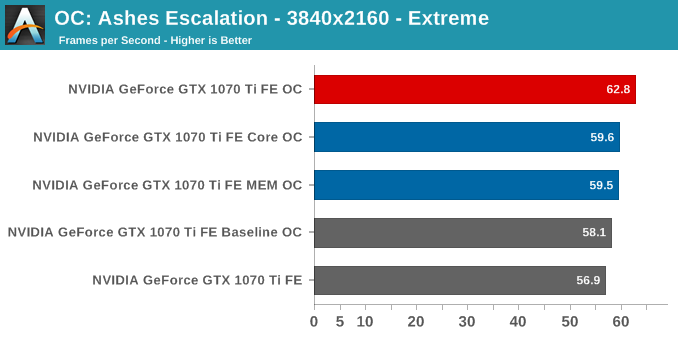
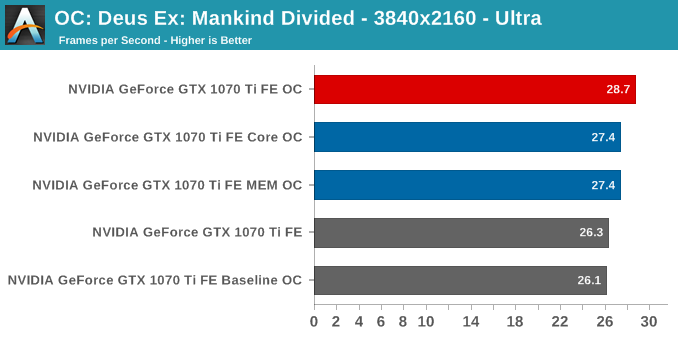
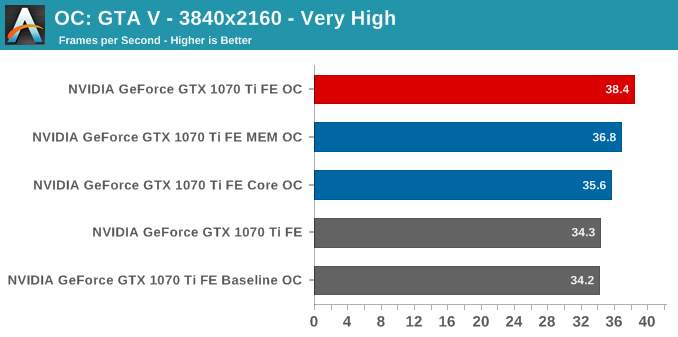
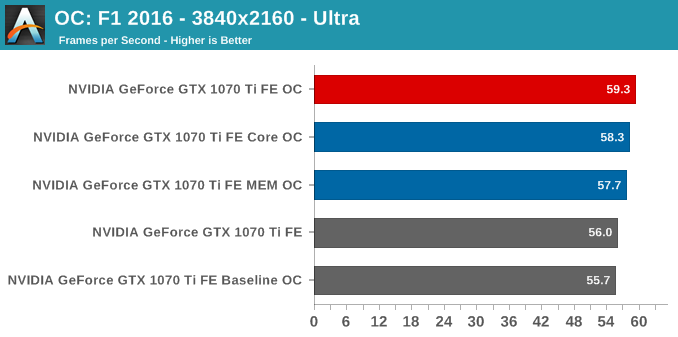
Although this is more of a cursory look than anything else, the combined overclock provides the best performance, just like it was for the GTX 1080 and 1070, although it seems like memory overclocking is more effective on the GTX 1070 Ti. Earlier, we mentioned how the GTX 1070 Ti compared to the GTX 1070 by having four more SMs but without any additional memory bandwidth, and perhaps that is playing a role here.
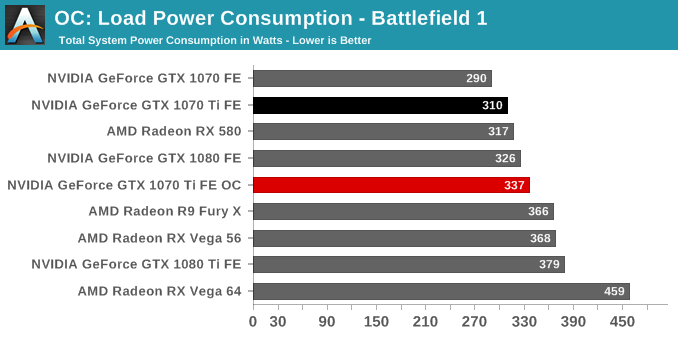
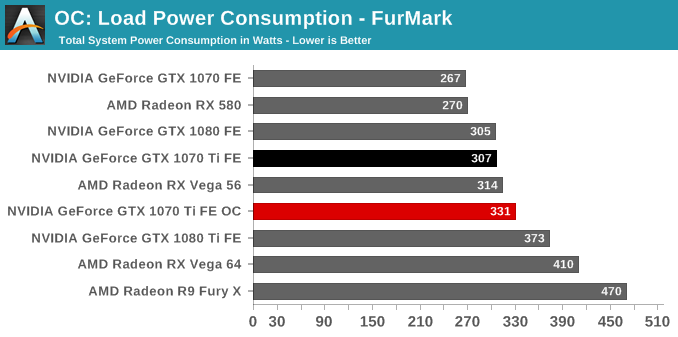
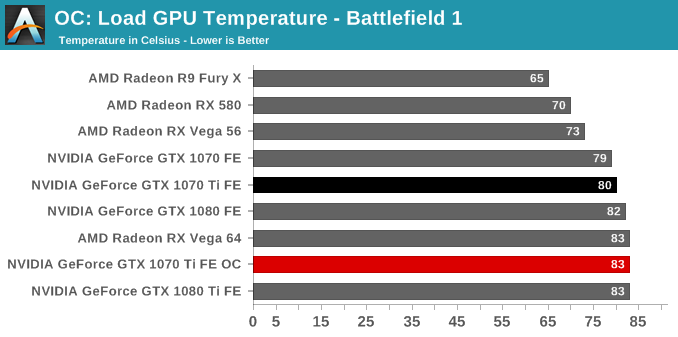
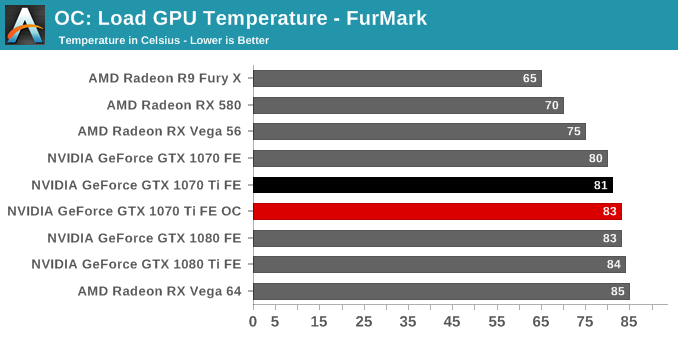
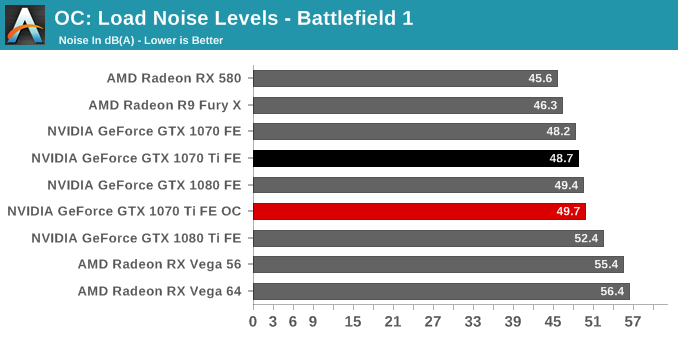
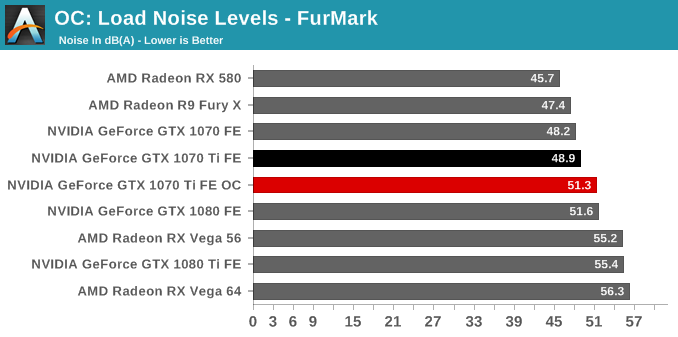
There isn't much to add on the power, temperature, and noise front. Understandably, the card will heat up a few more degrees and spin its blower faster, at the expense of ~25W at the wall, inasmuch as the 120% power limit will let it. As a casual overclocker, there may not be a lot to gain here; the GTX 1070 Ti FE already boosts to ~1800+MHz at stock, and squeezing 200MHz more with the anemic capabilities of NVIDIA's reference PCB won't make waves. And for hardcore overclockers, there would be little need of the reference board's power delivery system.










78 Comments
View All Comments
Destoya - Thursday, November 2, 2017 - link
I feel like you're ignoring cards like the 1050ti/1050 in order to better match your narrative. Both of those require no power connectors (75W TDP) and will reach 1080p60 easily for modern AAA games and 144 FPS on esports titles. Yes, both companies are making power hungry monster cards to satisfy high-end demand that get a lot of headlines, but the chip designs scale down incredibly well. Performance for low/mid-end systems has never been as good as it is now.The_Assimilator - Friday, November 3, 2017 - link
Yes yes, everybody should still be using teletype terminals and typewriters. Or even better, go back to scratching lines into cave walls with rocks, because that uses no power and creates no heat.Lord of the Bored - Friday, November 3, 2017 - link
Actually, it does create heat. Thermodynamics is a harsh mistress.catavalon21 - Thursday, January 10, 2019 - link
+1sonny73n - Friday, November 3, 2017 - link
Graphic and resolution mean the world to them because they have no life.theuglyman0war - Saturday, November 4, 2017 - link
I thought it was because God gave us two eyes that can see? ( the same reason I get my prescription glasses updated every year. Fidelity. )Is Lo Fi hip again?
Ranger1065 - Friday, November 3, 2017 - link
You should be removed ASAP dear Ciccio.TheJian - Thursday, November 2, 2017 - link
Bought mine at $499 (EVGA FTW2). Don't feel gouged at all. If it's gouging, they'd still be on the shelf. I'm guessing they'll be out of stock shortly. If they priced like you want, they'd have quarterly reports like AMD.. ROFL. That should not be the goal for NV, but rather to price as high as the market will accept...PERIOD. It is actually their JOB to do this.Sounds like you need to upgrade your job so you can afford better toys ;) AMD has lost $8B in the last 2 decades and looks like they only made money for a single quarter this time. They are predicting a down Q yet again (how can you have a bad xmas Q?) and just after all these launches. YOU ARE PRICING YOUR STUFF TOO LOW AMD!
bill.rookard - Thursday, November 2, 2017 - link
Well, that's not entirely accurate, AMD has had some nominally profitable quarters before this - not to the level of Intel for sure, but saying they've lost money every single quarter in the past 20 years is patently untrue. There were many times 'in the past two decades' when they were actually eating Intel's lunch, so enough of the hyperbole.Yes, they've not had an easy time since then, and have been in the dumps especially with their previous generation designs which, well, sucked. (caveat, the 8 core 8000 series actually did well on video encoding but that wasn't nearly enough)
As for pricing stuff too low? They HAVE to right now. Their issue is one of market share, and with their previous generation u-arch it couldn't remotely compete with Intel, and that pitiful share is the result. Now that they have a u-arch which is close to parity from power and performance, just wait to see what happens in the notebook space where the Intel IGP is pitifully bad compared to the Mobile Vega. Besides - the main 'desktop' space is, while not dying, it is without a doubt somewhat stagnant as most people have a laptop which is powerful enough to get stuff done, while being portable.
That is the larger market, and one that the Ryzen APU's will have a much better chance at picking up share in.
webdoctors - Thursday, November 2, 2017 - link
You;re right, there was I guess maybe 40% quarters were profitable last 10 years:https://ycharts.com/companies/AMD/eps